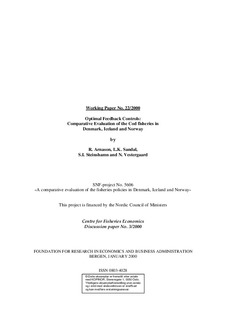| dc.description.abstract | The purpose of this paper is to compare the relative efficiency of the fish harvesting policies of Iceland, Norway and Denmark. We have chosen to concentrate on the cod fishery as this is the single most important fishery in all three countries. The three nations conduct their cod fisheries in quite different contexts. First, there is a difference in national control over the respective fisheries. Iceland has been in virtual sole control of her cod fishery. Norway, on the other hand, shares her cod stock, the Arctic cod, with Russia and must therefore decide on a harvesting policy jointly with Russia. Denmark is only one of several, mainly European Union, countries pursuing the North Sea cod fishery. In view of these differences in autonomy between the three countries, it is clearly of interest whether this shows up in their respective cod harvesting policies. Second, during the latter part of the period under study in this paper, the fisheries management systems of the three countries have been quite different. Iceland has since 1984 operated a more or less complete ITQ-system in her cod fishery. Norway has managed her cod fishery on the basis of quasi-permanent individual quotas. In Denmark, however, the fishery has for the past two decades essentially been managed on the basis of a licence limitation program supplemented with very short term (down to two months) non-permanent, non-transferable vessel quotas that, in the case the fishery is closed, may actually turn out to be worthless. This gives rise to the hypothesis that Iceland has greatest incentives and potential to manage their fish resources well on a long-term basis, and Denmark has least incentives as well as potential. Norway is somewhere between these two. The way the comparisons are performed is by looking at two main indicators: economic stock overexploitation and economic overharvesting. The results of this study show interesting differences, and the hypothesis is not confirmed. In fact, Denmark has least stock overexploitation as well as least overharvesting. Iceland is close to Denmark when it comes to stock overexploitation, and has actually less overexploitation when the total data period (55 - 97) is used for Iceland instead of the common data period (64 – 97). Norway performs worst with respect to stock overexploitation but has less overharvesting than Iceland. Especially in the common data period Norway and Denmark is close. When the total data period is used, however, both Iceland and Norway perform better than Denmark. The overall conclusion from this study is that, despite any differences between the countries, it is the similarity that is most striking, namely that both the stock overexploitation and the rate of overharvesting have been severe in all three countries. This impression outweighs the reported differences. | en |
